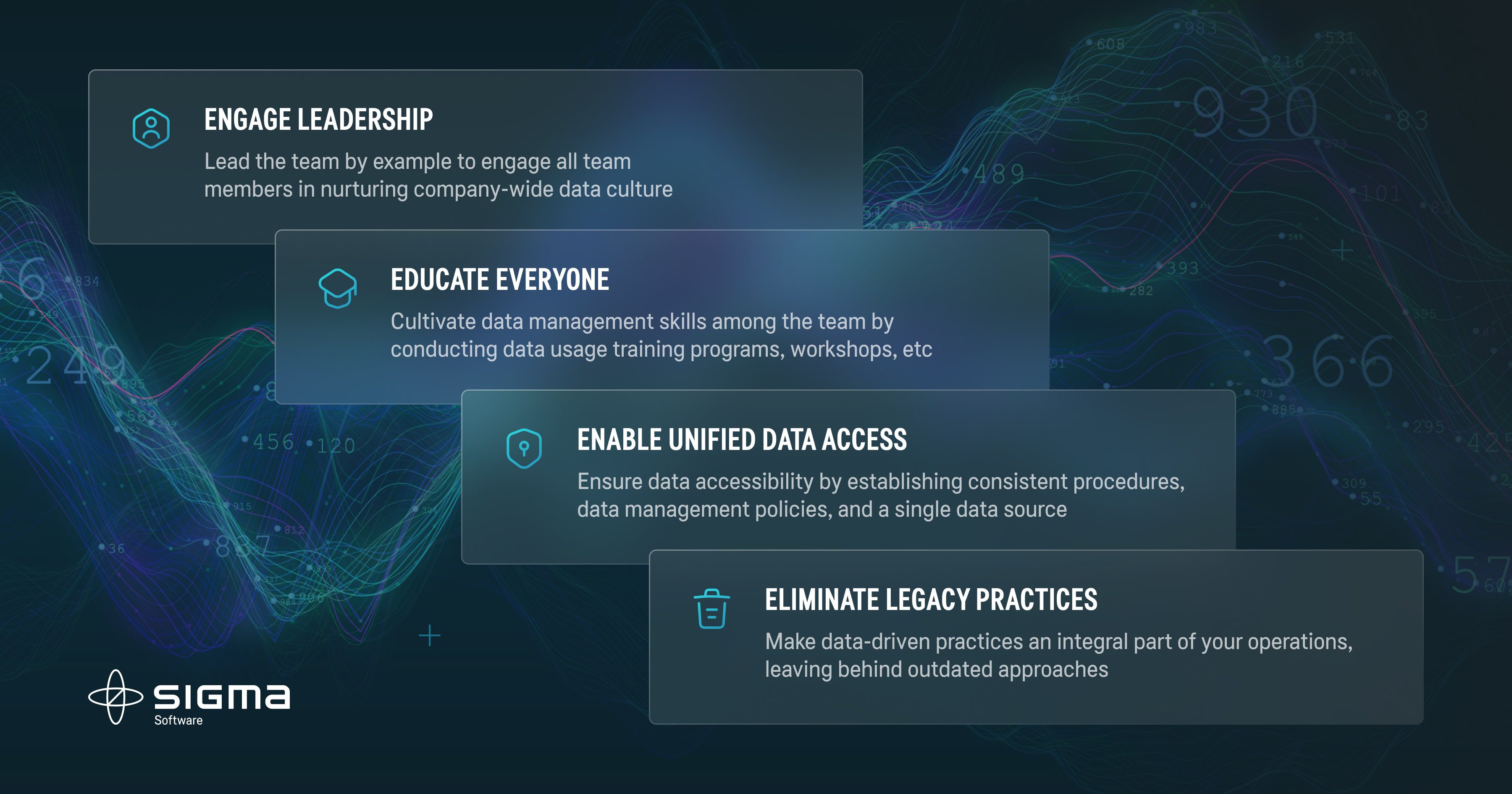What is a Data-Driven Organisation?
How to Become a Data-Driven Organization
Thank you for reaching out to Sigma Software!
Please fill the form below. Our team will contact you shortly.
Sigma Software has offices in multiple locations in Europe, Northern America, Asia, and Latin America.

USA

Sweden

Germany

Canada

Israel

Singapore

UAE

Australia

Austria

Ukraine

Poland

Argentina

Brazil

Bulgaria

Colombia

Czech Republic

Hungary

Mexico

Portugal

Romania

Uzbekistan
While the digital transformation direction is gaining momentum, data has become a valuable asset for businesses. In this article, we elaborate on the concept of data-driven organizations and explore the key facets that contribute to their success. You will learn about the essential steps to becoming data-driven, major challenges that businesses face on the go, and actionable recommendations to overcome them.
What is a Data-Driven Organisation?
How to Become a Data-Driven Organization
Data is the new power source for business growth across all industries – from marketing to technology. According to McKinsey, data-driven organizations are 23 times more likely to acquire customers. They also use data analytics solutions to better retain customers and become more profitable as a result. For example, companies that build their strategies based on customer data analysis achieve profitability levels almost 19 times higher than the market average.

Organizations relying on a data-driven approach have bigger chances of success. Although data-driven has already become a buzzword, many people still find it hard to formulate what this actually means. Let’s explore this in more detail.
Organizations that use data insights obtained through comprehensive analysis to empower business sustainability and growth are called data-driven. The fundamental principles of such organizations include a strong commitment to data-driven decision-making while treating data as a strategic asset. Such companies use data not only to power effective decisions but also to build business development strategy, identify business opportunities, mitigate risks, and optimize overall performance. Data analytics allows organizations to reveal new patterns, trends, and correlations that can further be used in their daily routine, thus improving outcomes for businesses.
Data-driven approach has proven its value across numerous use cases, fostering growth and continuous improvement for hundreds of corporations, including such major ones as:
The decision to move toward a data-driven approach entails multiple changes to the company’s processes and workflows. This includes transforming the way a company treats data by prioritizing data governance practices, ensuring data quality, security, and privacy metrics. Company-wide transformation also requires proactive investment in IT infrastructure and data management systems to streamline the collection, storage, and processing of big volumes of data.
Before adopting a data-driven approach, it is reasonable to analyze the company’s technical, business, and human resource capabilities and set clear goals you want to achieve with such transformation. This will help you formulate a business case and make sure your organization needs the change.
Once the decision is taken, you’ll need to identify key areas where the data-driven approach will bring the most value and pilot the transformation there. Another no less important aspect is KPI (Key Performance Indicators) system definition since you’ll definitely want to measure the progress and efficiency of your transformation initiative. Smooth transformation requires significant process flexibility, shift in corporate culture, and strong commitment from the organization’s leadership.
It’s worth noting that becoming a data-driven organization takes time and systematic effort. It is reasonable to prioritize specific directions, gradually transform core activities, and catalyze change within the company.
Becoming a truly data-driven organization encompasses many aspects, including but not limited to developing relevant data strategy, upskilling employees, implementing new systems to handle data, etc.
Here are key steps leading to the successful adoption of a data-driven organizational approach:
The idea of data culture embraces the shared behaviors and beliefs within an organization that prioritizes the value, practice, and promotion of data usage to improve decision-making. Every organization can encourage their employee’s new perceptions of data handing by following the fundamental four E’s rule of the data culture:

Data culture implementation is not a one-time activity. It is an ongoing initiative that requires continuous learning and readiness to adapt to changes. At the same time, data culture helps maintain data awareness in the organization. Data-literate employees process, analyze and interpret data more efficiently. Thus, your organization can make effective business decisions at all levels.
Data passes various stages through its existence, and companies have to make sure it’s appropriately safeguarded on each of those. Well-implemented Data Lifecycle Management (DLM) gives you the right instruments to sustain data confidentiality, integrity, and availability all the way from its creation to destruction. Apart from setting up unified data standards, DLM requires continuous investment of efforts in the following aspects as well:
As a rule, data-driven organizations have a centralized data system that serves as a single source of truth enabling all company departments to work with the necessary information. This involves democratizing data access and eliminating silos between data stored in different departments and systems. Data should not be confined to specific teams or limited to analysts only. It is important to securely share information with a broader range of employees and empower them to use it through routine processes to be more efficient in their daily operations.
Data analytics gives value to the collected data and transforms it into an effective source for decision-making. It is a tool that helps to optimize business performance, reduce costs, improve customer experience, or even develop new product features. The selection of the appropriate data analysis tool depends on several factors:
Companies may also require a custom data platform to address more complex tasks and meet specific business requirements, so then it is reasonable to engage Data Engineers. Apart from designing custom data platforms in line with business objectives, Data Engineers can help scale your data infrastructure and provide insights to optimize overall data management performance.
Businesses need to make decisions based on facts rather than assumptions. Efficient analytics helps to improve business strategies and development plans, securing timely and ongoing adaptation to changes. Businesses that use data also become more agile and adaptive, capable of quickly responding to market changes and customer demands.
It also makes sense to conduct regular process assessments and optimization to get maximum value from all resources invested in the transformation initiatives.
Transformation planning and change implementation is critically important for any business. However, you can’t predict all potential bottlenecks and challenges you may face during the transition to a data-driven approach. That’s why organizations have to remain flexible, be ready to spot process inconsistencies and areas for improvement, and smoothly navigate their way through the change.
An effective tracking process and clear metrics allow the company to monitor its performance, keep up with the trends, and make required improvements immediately.
The transition to a data-driven approach brings multiple challenges for companies as any other complex transformation initiative, including agile decision-making, improved employee engagement, and customer experience. Businesses face many operational and technical challenges on their way toward a data-driven model implementation:
Challenge 1: Education
Major roadblocks on the path to a data-driven organization are related to data literacy, technical skills, and cultural shifts among employees. Unfortunately, many companies underestimate the importance of these aspects, and this becomes an obstacle for a successful transformation.
Solution: It is important to remain consistent in promoting data awareness among its employees by:
Challenge 2: Excessive data
Organizations find it difficult to manage and extract meaningful insights from the vast amounts of data. Large amounts of data can overwhelm data processing and analysis capabilities, risking to turn into a data swamp. Lack of strategy on large data volumes storage, prioritization and optimal structure can eventually lead to increased management and maintenance costs that strain the budget.
Solution: Organizations can address the excessive data challenge by:
Challenge 3: Lack of Technical Expertise
Sound data management, software, and systems engineering require strong technical expertise. Unfortunately, the in-house teams may lack experts who could design and develop the data ecosystems compatible with the organization’s scalability, security, and availability requirements. As a result, slow response times, data inconsistencies, system vulnerability, and limitations can decrease the organization’s ability to safely derive valuable insights from data.
Solution: Organizations can overcome this challenge in several ways. They can focus on developing in-house tech capabilities among the team, including hiring and training the right talents. Otherwise, companies can engage external subject-matter experts who will help to adopt modern data management and analytics tools, as well as streamline all data processes.
To sum up, any company can become data driven. It is just a matter of having clear reasons to go through this transformation and prioritizing data investments. As any comprehensive initiative, it is a multi-year project that requires thorough planning. The good news is that it can be done step-by-step, and you can start with smaller changes, gradually scaling the initiative over time.
In case your company requires external consultancy to implement necessary changes in data processes or build data infrastructure, contact Sigma Software experts. With over 20 years of experience on the board, we will help you efficiently integrate analytics into your business and set up processes for maximized data value and data-driven business decision-making.

Sigma Software Group provides IT services to enterprises, software product houses, and startups. Working since 2002, we have build deep domain knowledge in AdTech, automotive, aviation, gaming industry, telecom, e-learning, FinTech, PropTech. We constantly work to enrich our expertise with machine learning, cybersecurity, AR/VR, IoT, and other technologies. Here we share insights into tech news, software engineering tips, business methods, and company life.
Linkedin profileWhat is a Data-Driven Organisation?
How to Become a Data-Driven Organization


A Software Bill of Materials (SBOM) is becoming one of the most important documents in modern software development. Still, many organizations struggle to create...

As cloud sovereignty becomes a strategic priority across the EU, Sigma Software applies its deep expertise and extensive experience to contribute to the develop...

Data is everywhere, yet its payoff isn't always there. Many IT leaders struggle with scattered analytics, rising storage costs, and unclear returns.We face...
Would you like to view the site in German?
Switch to German